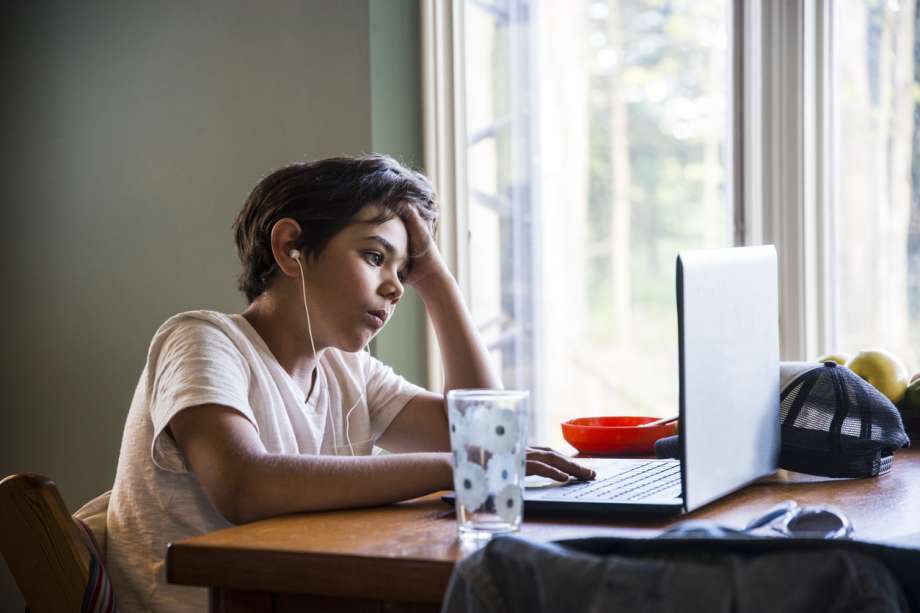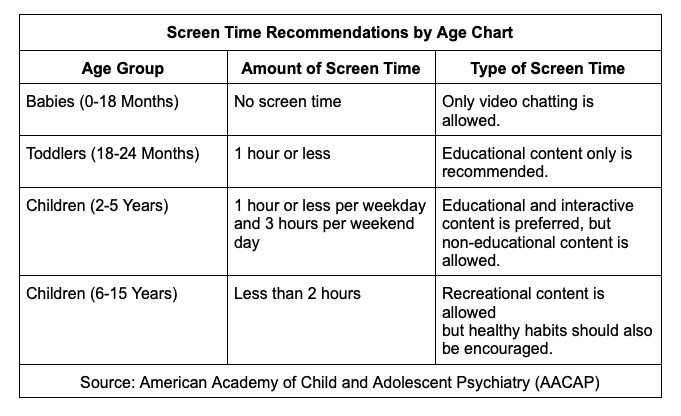Screen Time Recommendations By Age Chart

Is screen time harmful to a child's development and well-being?
Psychologists, pediatricians, and child development professionals are constantly investigating whether there is a negative relationship between screen time and children.
The current consensus is that excessive screen time is harmful to both children and adults, but some screen time can be totally fine and even beneficial in certain cases.
To make sense of what the right screen time limits are best for kids by age, we’ve developed a list of screen time recommendations to help reduce these negative side effects.
Learn how many hours of screen time your child should have per day and what kind of content they should be watching. Plus, get our Printable Screen Time Chart as a handy reminder!
How Much Screen Time Is Advised for Each Age Group?
According to the American Academy of Child and Adolescent Psychiatry (AACAP), parents should establish certain screen time guidelines to help reduce the negative impact screen exposure has on children. The AACAP sets guidelines on the amount and type of screen time for each age group, and they include:
- Children under the age of 18 months should not be exposed to any screen time. However, video chatting with family is accepted.
- Children between 18 and 24 months can have some screen time (less than 1 hr), but the program should be highly-educational. A caregiver should be watching them at all times.
- Children between the ages of 2-5 can have non-educational screen time for about 1 hour per day and 3 hours on weekend days.
- For children 6 years and older, the AACAP recommends limiting media time to 2 hrs and encouraging healthy habits.
- Children should not have any screen time during meals or when outdoors.
- Parents should use parental controls to choose what content their child is exposed to and to control how much screen time their child is exposed to daily.
- Parents should not use screens to calm down children.
- Children should not have any screen time for at least half an hour before bed.
What Does the CDC Recommend for Screen Time?
According to the Centers for Disease Control and Prevention, children should spend less time on screens and more time participating in physical activities during their free time like walking a dog or playing basketball. They should get at least one hour of exercise every day. The CDC has set some guidelines for screen time.
- The CDC advises parents to not give any screen time to children under the age of 2.
- The CDC asks parents to remove TVs from a child’s bedroom and limit screen time to 1-2 hours daily for children between the ages of 8 and 14.
Which Age Groups Are Most Affected by Screen Time?

Children between the ages of 10 and 19 are the most affected by screen time. Excessive screen time does harm their health. However, additional problems arise at this age from screen exposure, and they include cyberbullying and screen addiction.
Cyberbullying could cause school-aged children to fall into depression which could affect their daily life. According to the AACAP, during screen time, teens and tweens may be exposed to risk-taking behaviors, dangerous challenges, inappropriate sexual content and drug use.
Today, kids and teens are constantly exposed to social media influencers on TikTok and YouTube that promote harmful messaging in order to influence their view of the world. Harmful influencers like Andrew Tate have been publicly criticized for spreading misogynistic and violent messages to an audience of millions of children on their online platforms. This is why it is crucial to know what type of content your child is being exposed to daily.
What Are the Benefits of Limiting Kids’ Screen Time?
According to Youth First, limiting children's screen time has numerous benefits. Limiting screen time improves sleep habits, helps children focus more, boosts academic success, lowers childhood obesity, improves vision, and lowers depression.
Screen Time is Harmful to Sleep
Blue light is emitted by screens. Blue light disrupts our circadian rhythm. This postpones the melatonin surge required to assist us in falling asleep. It also hurts sleep quality.
According to Cleaveland Clinic, toddlers need 11-14 hrs of sleep, preschoolers need 10-13 hrs of sleep, children between the ages of 6 and 12 need 9-12 hrs of sleep, and teenagers need 8-12 hrs of sleep.
If children do not get the required amount of high-quality sleep, they may experience poor brain development, learning difficulties, and negative emotions, according to Children’s Hospital Colorado.
Screen Time Impacts Children’s Ability to Focus
According to the National Library of Medicine, screen time use affects children’s attention span and concentration. When children are online, they are constantly interrupted by ads and notifications, and they spend hours watching short videos that don’t require concentration. This impairs children's ability to focus on other tasks.
Screen Time Can Affect Academic Success.
Sitting in front of a screen for too long can affect children’s academic performance. Children who spend too much time watching TV, video chatting with friends, or scrolling through social media, spend less time doing school work and participating in physical activities, which is crucial for academic success and child development.
More Screen Time is Connected to Obesity Rates
According to the Mayo Health Clinic System, there is a link between excessive screen exposure and obesity. Children prefer to sit in front of the television rather than play outside or engage in other physical activities. This can lead to weight gain and obesity. There are many advertisements today that promote unhealthy foods and beverages, which can have an indirect impact on adults' and children's food choices.
Research also reveals that children who have TVs in their rooms are more prone to obesity in the future in comparison to those who don’t. According to Great Schools, 70 percent of American children aged 8 to 18 have TVs in their rooms. Unfortunately, this percentage is on the rise.
Screen Time Can Damage Your Child's Vision

Being exposed to long periods of screen time causes eye dryness, eye fatigue, and nearsightedness. When young children stare at a screen and concentrate for an extended period of time, they tend to blink less frequently, resulting in dryness and eye fatigue.
In addition, when children watch television, they are usually indoors. According to the American Academy of Ophthalmology, when spending too much time inside, children tend to develop nearsightedness due to the lack of exposure to daylight.
Screen Time is Linked to Anxiety and Depression
The Children’s Hospital of Philadelphia states that there is a link between daily screen time exposure and depression. Watching too much TV can negatively affect the mental health of children and adolescents. However, there is no effect on children’s well-being if parents limit their screen time.
How Should I Limit My Child's Screen Time?
It is very important to curb your family’s or child’s screen time, and you can achieve this by doing the following:
- Print out our screen time chart log to help determine how much screen time your child is exposed to daily.
- Set certain time periods for screen use, family time, and school work.
- Remove the TV from your child’s bedroom, or make sure your child does not use it without your permission.
- Set screen time guidelines and be firm. Some guidelines could include not using any digital devices when eating, studying, or spending time with family.
- Download parental control apps that set a limit on the amount of screen time your child is allowed.
- Encourage your child to spend more time in nature or play indoors without the use of screens.
- Create a family media use plan that contains screen time rules for the whole family. The American Academy of Pediatrics (AAP) also recommends choosing educational content for screen time and states that interactive screen time can be healthy for kids.
Screen Time Recommendations by Age Chart

The Bottom Line on Kids and Screen Time
All in all, an excessive amount of screen time harms both the mental and physical health of your child. Limiting screen time is proven to reduce the negative influence. Educational and interactive content is highly preferred for young children. You can limit your child’s screen time by setting a list of screen time rules. Small changes can make a big difference.

